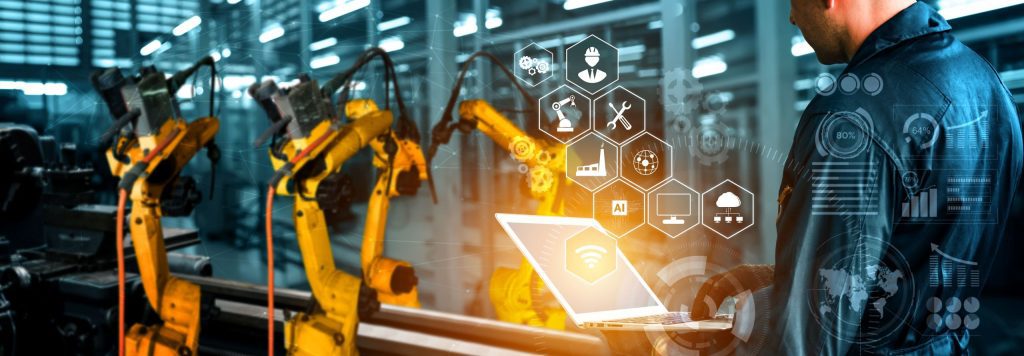
It is quite an understatement to say that AI integration experienced tremendous growth over the last year and a half, charged by the maturation of large language models (LLMs). Every industry has been affected—whether directly by use cases that are ready to go to market or indirectly by transformations that are happening fast and furiously to ensure business sustainability and growth in the AI world.
While Schneider Electric has been a leader in digitization and early applications of artificial intelligence (AI), I like to think of AI as already being everywhere. It’s in our living rooms, our homes, our buildings, and our factories. We have watched AI progress exceptionally with unprecedented speed. Now the question most companies have to ask themselves is not, “When are we going to leverage AI.” Instead, it is, “How fast are we going to leverage AI?”
The industrial sector is not immune from this widespread AI integration and must figure out what to do about it in a way that aligns with a company’s core business strategy. At Schneider Electric, we find innovative ways already-digitized applications can become AI-infused to deliver even greater insights and business intelligence from data. Harnessing decades of data, some form of AI is inherent in all Schneider technologies, whether on the plant floor, inside an asset, or part of an entire enterprise. From machine learning algorithms that serve up predictive analytics to integrated LLMs that act like copilots, AI is accelerating Schneider’s industrial automation and energy management playbook.
For instance, Schneider recently entered a memorandum of understanding (MOU) with Hy Stor Energy to advance integrated, off-grid green hydrogen production and energy storage at scale. Through this MOU, Schneider is providing the company not only with automation and safety solutions and AVEVA process operation platforms, but also with AI optimization software that improves weather analysis, enables predictive operations, and finetunes digital energy management solutions. This digital AI-driven strategic coalition will enable Hy Stor Energy to deliver 100% carbon-free energy to its customers, providing safe and reliable renewable energy on demand.
For any AI project to succeed, there are three elements that must be considered:
The human element of AI
At CERA Week earlier this year, Schneider Electric CEO Peter Herweck said, “As far as I am concerned, every AI begins and ends with the human element”. He describes this aspect of AI as human intelligence with AI, or “HI with AI.” Hi, humans!
First, humans are essential in the loop of building and training AI models to ensure greater accuracy and relevance of the data feeding the models, drawing on their very human domain experience. Second, humans are at the core of the workplace change that is necessary for ensuring successful AI integration. This kind of change management could mean bringing new people into the workforce or supporting educating and upskilling the existing workforce to help accelerate today’s AI advancements. Focusing on this crucial human element creates a more efficient operation, not only for Schneider as we leverage these innovations in our own factories but also for our customers. Keep in mind that employees across generations will want to turn to AI as an easy button of sorts. I personally grew up watching “The Jetsons,” where George Jetson could just push some buttons that took care of everything. Wouldn’t that be cool if employees could have the Jetson equivalent of AI in a very safe, responsible, and sustainable way?
Without change management on AI integration and usage, even the best and most seamless AI models are destined to fail. That brings up my second point: AI will never succeed unless it is trustworthy.
Trust in AI
For a mission-critical sector, such as energy, trust in AI is imperative and must be treated at the same level of cybersecurity. While the quality of the data used to build and train the model is the starting point, trust in AI also is borne from a secure-by-design approach. What does this mean? It’s simple. Cybersecurity protocols must be built into AI tools, solutions, and processes instead of being regarded as an afterthought.
Strengthening trust in AI also means protecting intellectual property and the enterprise’s crown jewels. For the energy sector, this level of trust is paramount as the sector invests in R&D to create or mature new technologies and sources of energy needed to accelerate the energy transition.
For example, Schneider’s EcoStruxure™ Automation Expert is a software-defined industrial automation solution that creates a safe environment where customers can take data or pull assets from Schneider or other parts of their enterprise to make improvements throughout the operational lifecycle within a cybersecure environment.
Collaboration on AI projects
As I have said, AI is in everything that Schneider does. To be successful with full vertical integration, however, collaboration with partners is essential. In fact, collaboration is how to start to make AI transformations to remain competitive in an AI-first world.
For instance, Schneider is partnering with Intel to provide the AI modules as part of the aforementioned EcoStruxure™ Automation Expert solution. Working with Intel, we can push the boundaries of software-led automation to optimize industrial operations from design to maintenance. Indeed, partnership is a sector-wide path forward for AI integration.
If you are a company, like Schneider Electric, that has been gathering data for decades, you have to make sure that you are contextualizing that data. That is an area where we also work with our customers as partners to ensure the data is empowering them to make the right decisions to solve their most pressing problems.
Maximize AI opportunities
There is no question that AI — done right — can level up productivity, operational efficiency, and agility by connecting automation hardware and industrial software to work together seamlessly, even if they come from different suppliers. The key to success is finding a partner with deep domain experience paired with industrial tech leadership to help you maximize the opportunities that AI presents for you, your business, and the future of both.
Learn more about AI: What is Industrial AI? (se.com)
About the author

Heather Cykoski, Senior Vice President Industrial and Process Automation
Heather Cykoski, Senior Vice President of Industrial and Process Automation and Member of the Executive Leadership Team, leads the industrial automation business in North America to be our customer’s digital and automation partner for sustainability and resiliency.
A passionate global business leader with 25 years of international experience leading multi-dimensional, multi-cultural teams across the energy value chain, Heather brings a strong track record of excellence in business and leadership.




Add a comment